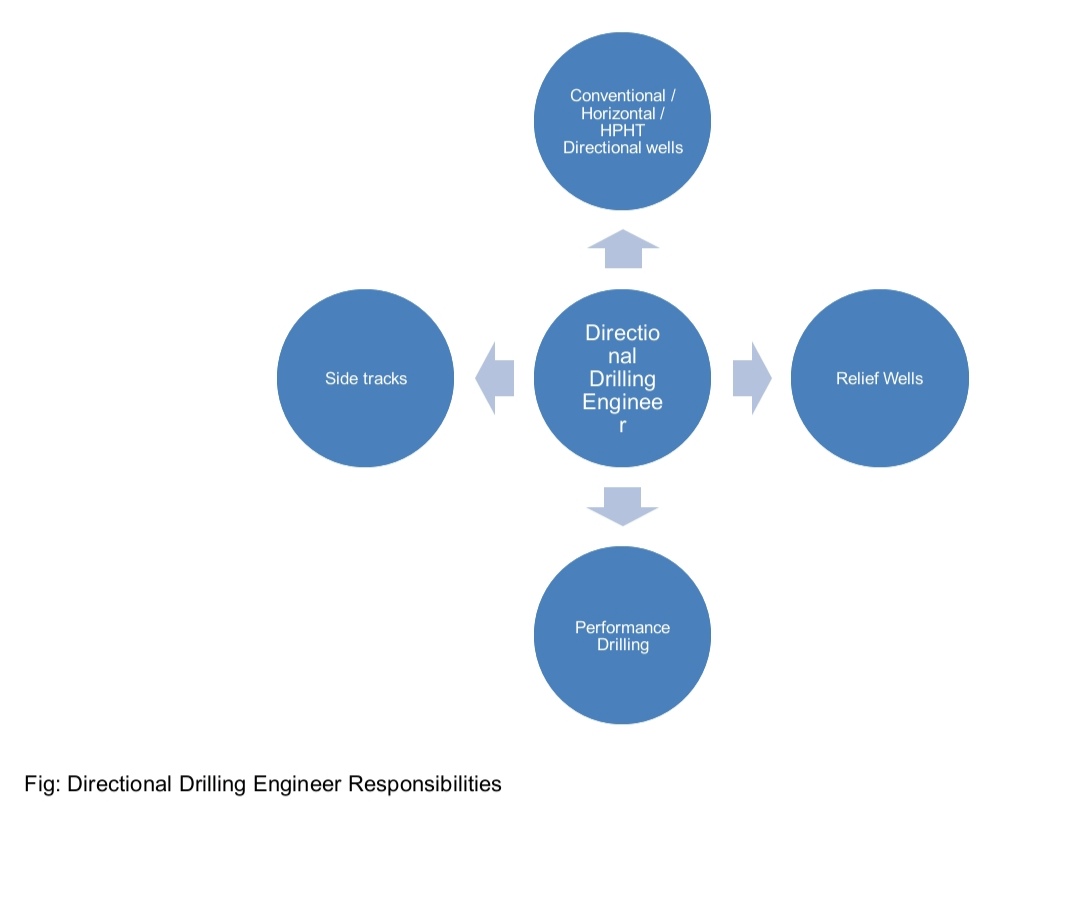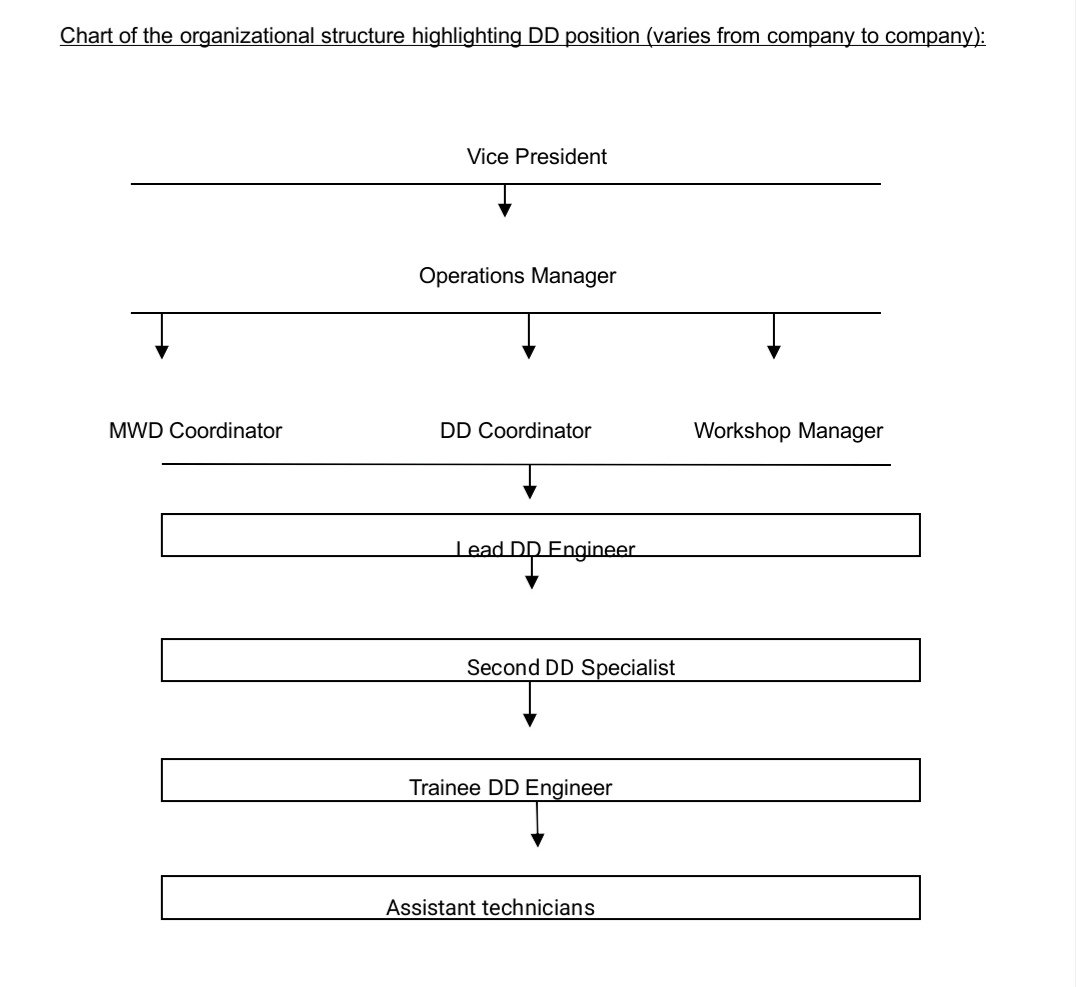Being a Directional Drilling Engineer
One of the most prestigious job in the Oil and Gas upstream industry is of Directional Drilling Engineer. The purpose of this paper is to evaluate the responsibilities of Directional Drilling (DD) Engineer and how this precious segment of the Oil and Gas industry is contributing to its success.
There are many roles that converge under the designation of DD. Starting from drilling the normal directional well till killing the blown-out well via Relief well are some of the few responsibilities featuring under DD badge. Below figure shows a glimpse of a bigger picture:

Chart of the organizational structure highlighting DD position (varies from company to company)
The segment of Directional drilling which we touch in this research project is Sidetrack. Basically, a client while drilling there vertical well left the fish (the broken drill string) inside the borehole. The team of Directional Drilling Engineers had been called to bypass that fish. I as a part of the DD team went on the location in order to research the working principle, the execution and overall impact of Directional Drilling.
A statement of DD duties:
Directional Drilling Engineer on job main duties and tasks were as following:
- Maintain DD tools inventory.
- Strapping all DD tools present on the rig site.
- Suggesting which tool to pick up for a particular job and which to keep as back up.
- A proper check on QHSE and to keep on tracking good practices.
- Supervising while picking up the tools on the Rig floor.
- Bit selection.
- Instructing the driller in order to navigate well to the right direction
- Accepting downhole Measurement while Drilling surveys and keep on planning ahead to achieve the planned well path.
- Perform anti-collision checks specifically at the time of sidetrack or if there is near offset well.
- Post job dispatching of tools back to the Company’s yard for maintenance.
After arriving on the location, the team of DD inspected the Drilling motors. The main purpose of the positive displacement drilling motors is to generate mechanical energy from the hydraulic energy of the drilling fluids and converge that energy to the drive shaft connected with drill bit. This helps in generating more torque, as well increase the revolution per minute of drill bit and in the present case of Sidetrack, we want only the drill bit to rotate instead of the whole drill string from surface.
On the surface, then pick up the mud motor on the rig floor, DD set the bent housing of mud motor and orient it at the bend of 1.72deg which was selected from 0-3deg chart. The purpose of the bend was to keep the bottom part of the bottom hole assembly with angled from vertical so it helps in generating a new hole when went down hole. This bend is basically aligned with the Measurement while drilling tool which turn send signals through its pulses from bottom of hole to surface equipment. The LSS (lower sleeve stabilizer) had been placed on the bottom sleeve part of the mud motor. The test to check the motor on surface was called as SHT (Shallow hole test) where we pumped designated gallon per minutes (gpm) of mud through the mud motor in order to check its vibration and pressure holding capacity. The drill bit selected to run with the assembly was tricone insert bit. The reason to use tricone was because of the stability it provides downhole while doing the side track.
The client drilled the well till 2873m where they fished the drill assembly in 8.5’’ section. The fish of 10m length lied at the bottom and the cement plug was placed for side track. The sidetrack is of two types, one is cased hole side track where the casing need to be cut and other is open hole sidetrack where a new hole is created in the drillable formation. We are focusing on the later type.
After making up the drill bit with Directional assembly, rig crew started the drill string to run in hole. The 9 5/8’’ casing point came at 2563m and afterwards DD keep on tracking surveys( at specific depth Measurement while drilling tool send Inclination and Azimuth) every stand ,i.e. 30m to find out the actual well path (Note: I cannot mention actual surveys because of Confidentiality of client data). At the depth of 2768m drill bit tag on the cement plug. Pick up the string 5m and then start the pumps at 450gpm and come down to tag on cement plug with minute weight on bit, 2klbs(kilo pounds). Initially with 30-40rpm, ROP(Rate of penetration) was 1 to 2 minutes to drill a meter but after 30m cement got more compressive cement and ROP reaches 3.5-4.5minutes to drill a meter. After overviewing the cement DD decided to initiate side track.
DD oriented the bend of the motor at the designated direction of plan and with mud pump pumping at 490gpm asked the driller to tied down the brake handle for 30min which allowed the bit to work itself into the formation and to start a ledge for sidetracking. Afterwards, DD had started Time drilling giving 5 minutes to slack every inch. While time drilling, mud samples were taken every meter from shale shaker to keep an eye on percentage of formation versus cement. As the percentage of formation increases, the weight on bit had been increased to 4 klbs. The slack time to 3min per inch drilled. As soon as the sample showed 75% formation this showed that side track is a success. The kick off point(the point from where the new hole has been created from the old hole) for the side track was given as 2769m and DD slide drill 3.5m ahead to gain in a side track where formation showed 95% in samples. The driller had been asked to pick up the drill string above kick off point and then come back to check side track point smoothness which was very optimistic.
Afterwards, pull out the drill string out of hole and changed the bend of the motor to 1.15deg, changed the bit to PDC, took the Tool Face Correction and came back to bottom to drill ahead with optimized Rate of Penetration and crossed the fish with the safe distance of 5m (center of old well to center of new well). As soon we crossed the fish safely client asked to pull out of hole to drill ahead with their own rig drilling assembly.
When tools arrived on surface DD checked them physically, checked the mud motor bearing section, checked the gauge of LSS and Lay down the tools on rack. DD handed the final Side track report to client and after delivering a perfect job upon client also handed an appreciation letter to the whole team.
My research in this segment of Directional Drilling specifically while on field with DD gives me an eye popping experience. I found that Side tracks not only helps in continuing with new hole from older one but can also have many other usage, like wise to drill several laterals in horizontal section in order to enhance production as well as to explore old wells by cutting the casing of old well and drill in some reservoir instructed direction to explore different formations.
The financial impact of this technology is huge. Taking an example of this project, by skipping the use of Directional drilling technology client had no choice other than pain stacking milling the whole 10m fish which could take approximately one month. This could increase the cost of project by US $750k. Other than that the only option was to abandon the well whose cost was already in millions of dollars. This cost increased nearly four times if this incident happened in offshore well.
My research concludes that the performance, the steering ability and accuracy to hit the reservoir is best served from the influence of Directional Drilling and the Directional Drilling Engineer is the integral part of it, the one who navigates the well in the right path. And don’t forget, he is the Directional Drilling engineer who steered the relief well in order to finish the horror of Gulf of Mexico oil spillage back in 2010.
Bibliography:
Dippl and Prassel, Drilling Engineering, Curtin University of Technolgy, Vol i.
Mian M.A., Petroleum Engineering Handbook For The Practicing Engineer, Vol.II, PennWell Publishing, Tulas Oklahoma.
Source: This is a full version of an article by our student Mohammad Hassaan Khan. This article was supervised by Prof. Vladimir Biruk.